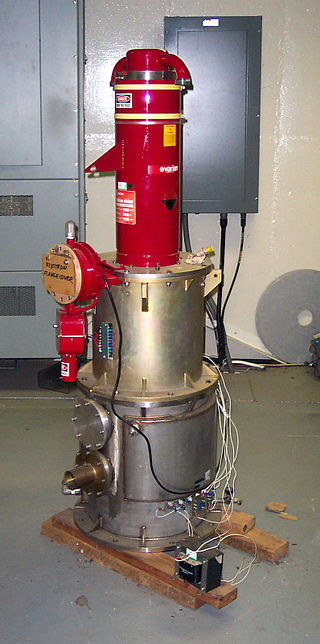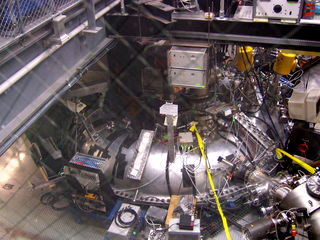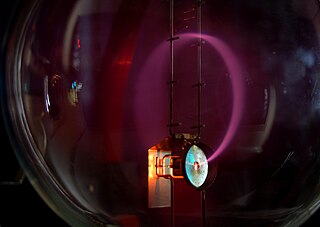Related Research Articles

A klystron is a specialized linear-beam vacuum tube, invented in 1937 by American electrical engineers Russell and Sigurd Varian, which is used as an amplifier for high radio frequencies, from UHF up into the microwave range. Low-power klystrons are used as oscillators in terrestrial microwave relay communications links, while high-power klystrons are used as output tubes in UHF television transmitters, satellite communication, radar transmitters, and to generate the drive power for modern particle accelerators.

A linear particle accelerator is a type of particle accelerator that accelerates charged subatomic particles or ions to a high speed by subjecting them to a series of oscillating electric potentials along a linear beamline. The principles for such machines were proposed by Gustav Ising in 1924, while the first machine that worked was constructed by Rolf Widerøe in 1928 at the RWTH Aachen University. Linacs have many applications: they generate X-rays and high energy electrons for medicinal purposes in radiation therapy, serve as particle injectors for higher-energy accelerators, and are used directly to achieve the highest kinetic energy for light particles for particle physics.
Plasma diagnostics are a pool of methods, instruments, and experimental techniques used to measure properties of a plasma, such as plasma components' density, distribution function over energy (temperature), their spatial profiles and dynamics, which enable to derive plasma parameters.

The Large Electron–Positron Collider (LEP) was one of the largest particle accelerators ever constructed. It was built at CERN, a multi-national centre for research in nuclear and particle physics near Geneva, Switzerland.
Ultra-high vacuum is the vacuum regime characterised by pressures lower than about 1×10−6 pascals. UHV conditions are created by pumping the gas out of a UHV chamber. At these low pressures the mean free path of a gas molecule is greater than approximately 40 km, so the gas is in free molecular flow, and gas molecules will collide with the chamber walls many times before colliding with each other. Almost all molecular interactions therefore take place on various surfaces in the chamber.

High-energy nuclear physics studies the behavior of nuclear matter in energy regimes typical of high-energy physics. The primary focus of this field is the study of heavy-ion collisions, as compared to lighter atoms in other particle accelerators. At sufficient collision energies, these types of collisions are theorized to produce the quark–gluon plasma. In peripheral nuclear collisions at high energies one expects to obtain information on the electromagnetic production of leptons and mesons that are not accessible in electron–positron colliders due to their much smaller luminosities.
The ionization chamber is the simplest type of gaseous ionisation detector, and is widely used for the detection and measurement of many types of ionizing radiation, including X-rays, gamma rays, alpha particles and beta particles. Conventionally, the term "ionization chamber" refers exclusively to those detectors which collect all the charges created by direct ionization within the gas through the application of an electric field. It uses the discrete charges created by each interaction between the incident radiation and the gas to produce an output in the form of a small direct current. This means individual ionising events cannot be measured, so the energy of different types of radiation cannot be differentiated, but it gives a very good measurement of overall ionising effect.
Plasma acceleration is a technique for accelerating charged particles, such as electrons, positrons, and ions, using the electric field associated with electron plasma wave or other high-gradient plasma structures. The plasma acceleration structures are created either using ultra-short laser pulses or energetic particle beams that are matched to the plasma parameters. These techniques offer a way to build high performance particle accelerators of much smaller size than conventional devices. The basic concepts of plasma acceleration and its possibilities were originally conceived by Toshiki Tajima and John M. Dawson of UCLA in 1979. The initial experimental designs for a "wakefield" accelerator were conceived at UCLA by Chandrashekhar J. Joshi et al. Current experimental devices show accelerating gradients several orders of magnitude better than current particle accelerators over very short distances, and about one order of magnitude better at the one meter scale.

The Madison Symmetric Torus (MST) is a reversed field pinch (RFP) physics experiment with applications to both fusion energy research and astrophysical plasmas.

The AWAKE facility at CERN is a proof-of-principle experiment, which investigates wakefield plasma acceleration using a proton bunch as a driver, a world-wide first. It aims to accelerate a low-energy witness bunch of electrons from 15 to 20 MeV to several GeV over a short distance by creating a high acceleration gradient of several GV/m. Particle accelerators currently in use, like CERN's LHC, use standard or superconductive RF-cavities for acceleration, but they are limited to an acceleration gradient in the order of 100 MV/m.

The Proton Synchrotron is a particle accelerator at CERN. It is CERN's first synchrotron, beginning its operation in 1959. For a brief period the PS was the world's highest energy particle accelerator. It has since served as a pre-accelerator for the Intersecting Storage Rings (ISR) and the Super Proton Synchrotron (SPS), and is currently part of the Large Hadron Collider (LHC) accelerator complex. In addition to protons, PS has accelerated alpha particles, oxygen and sulfur nuclei, electrons, positrons, and antiprotons.

The hot-filament ionization gauge, sometimes called a hot-filament gauge or hot-cathode gauge, is the most widely used low-pressure (vacuum) measuring device for the region from 10−3 to 10−10 Torr. It is a triode, with the filament being the cathode.

The mass-to-charge ratio (m/Q) is a physical quantity relating the mass (quantity of matter) and the electric charge of a given particle, expressed in units of kilograms per coulomb (kg/C). It is most widely used in the electrodynamics of charged particles, e.g. in electron optics and ion optics.

Superconducting radio frequency (SRF) science and technology involves the application of electrical superconductors to radio frequency devices. The ultra-low electrical resistivity of a superconducting material allows an RF resonator to obtain an extremely high quality factor, Q. For example, it is commonplace for a 1.3 GHz niobium SRF resonant cavity at 1.8 kelvins to obtain a quality factor of Q=5×1010. Such a very high Q resonator stores energy with very low loss and narrow bandwidth. These properties can be exploited for a variety of applications, including the construction of high-performance particle accelerator structures.
A particle accelerator is a machine that uses electromagnetic fields to propel charged particles to very high speeds and energies, and to contain them in well-defined beams.

A storage ring is a type of circular particle accelerator in which a continuous or pulsed particle beam may be kept circulating typically for many hours. Storage of a particular particle depends upon the mass, momentum and usually the charge of the particle to be stored. Storage rings most commonly store electrons, positrons, or protons.
Charged particle beams in a particle accelerator or a storage ring undergo a variety of different processes. Typically the beam dynamics is broken down into single particle dynamics and collective effects. Sources of collective effects include single or multiple inter-particle scattering and interaction with the vacuum chamber and other surroundings, formalized in terms of impedance.

The extended interaction oscillator (EIO) is a linear-beam vacuum tube designed to convert direct current to RF power. The conversion mechanism is the space charge wave process whereby velocity modulation in an electron beam transforms to current or density modulation with distance.

The Future Circular Collider (FCC) is a proposed particle accelerator with an energy significantly above that of previous circular colliders, such as the Super Proton Synchrotron, the Tevatron, and the Large Hadron Collider (LHC). The FCC project is considering three scenarios for collision types: FCC-hh, for hadron-hadron collisions, including proton-proton and heavy ion collisions, FCC-ee, for electron-positron collisions, and FCC-eh, for electron-hadron collisions.
Explorer 55, also called as AE-E, was a NASA scientific satellite belonging to series Atmosphere Explorer, being launched on 20 November 1975 from Cape Canaveral Air Force Station (CCAFS) board a Thor-Delta 2910 launch vehicle.
References
- ↑ Iadarola, G.; Bartosik, H.; Rumolo, G.; Arduini, G.; Baglin, V.; Banfi, D.; Claudet, S.; Domınguez, O.; Müller, J. Esteban; Pieloni, T.; Shaposhnikova, E.; Tavian, L.; Zannini, C.; Zimmermann, F. (17 June 2014). Analysis of the Electron Cloud Observations with 25 ns Bunch Spacing at the LHC (PDF). IPAC2014: Proceedings of the 5th International Particle Accelerator Conference.